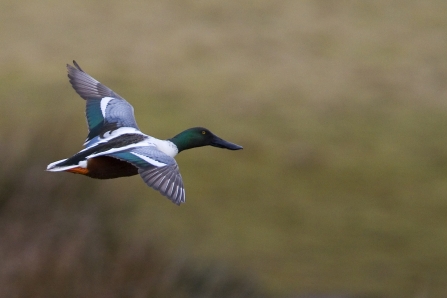
South Efford Marsh. Photo, Kevin McDonagh
South Efford Marsh
Know before you go
Dogs
When to visit
Opening times
All dayBest time to visit
All year roundAbout the reserve
This nature reserve is one of South Devon's best bird watching sites. South Efford Marsh is a patchwork of saltmarsh and grazing fields which lay next to the beautiful winding course of the River Avon. Life at the reserve is governed by a tidal gate which allows sea water to flow in at high tide. The gate was installed by the Environment Agency in 2011.
Ash dieback
The disease ash dieback is now widespread in the UK and is present at many of our nature reserves, so we carry out tree felling across our sites in winter months. For your own safety please observe temporary path diversions and closures.
Where possible we will leave affected ash trees in place to decay naturally as an important habitat for wildlife. We plan to only fell diseased ash trees which pose a threat to people or infrastructure. Before trees are felled, we will check whether any rare or protected wildlife is present. If it is, we will postpone or avoid felling these trees. No felling will take place during the bird nesting season.
DWT’s Saving Devon’s Treescapes project are working with communities, landowners and businesses to help make Devon's precious treescapes more resilient in the face of ash dieback. Find out how you can get involved here.
NOTICE: If you are visiting our reserves, please note that there have been instances of H5N1 Avian bird flu found in birds in Devon. There is very low risk to public health, but we do ask that if you come across any unusual or unexplained bird deaths on or near our reserves please do not touch them and report them to Defra here or call 03459 335577. Please also report your findings to DWT by email at contactus@devonwildlifetrust.org
Habitat
Contact us
Location map
How to get to South Efford Marsh

Shoveler. Photo, Neil Bygrave
Salt lovers
The reserve is now home to some rare salt-loving plants such as sea purslane, glasswort and sea spurry. It's also an important feeding place for lots of birds including curlew, ducks and little egrets.
A walk out to the reserve's wildlife hide brings you close to the action, giving great views of birds feeding nearby. Look out too for the tracks, mud slides and droppings (known as spraint) of otters left as they cross the path where you tread.
Dropping a bombshell
South Efford Marsh has a fascinating history. One night in 1943 a German bomber dropped its bombs on the estuary hitting the sea wall that still stands today around the reserve. This allowed sea water to flood in. This breach remained for the next decade and local people can still remember swimming in the bomb crater.
South Efford Marsh aerial tour (https://www.youtube.com/watch?v=1ekZu202ZZo)
Take to the skies with this unique aerial tour of South Efford Marsh nature reserve. Courtesy of BBC.
Take to the skies
Get a bird's-eye view of the reserve in this unique tour of South Efford Marsh.
Plan your visit to South Efford nature reserve with this guide
Become a member and support our work
The vital work we do for nature depends on the support of people who care about the future of Devon’s wildlife and wild places.
